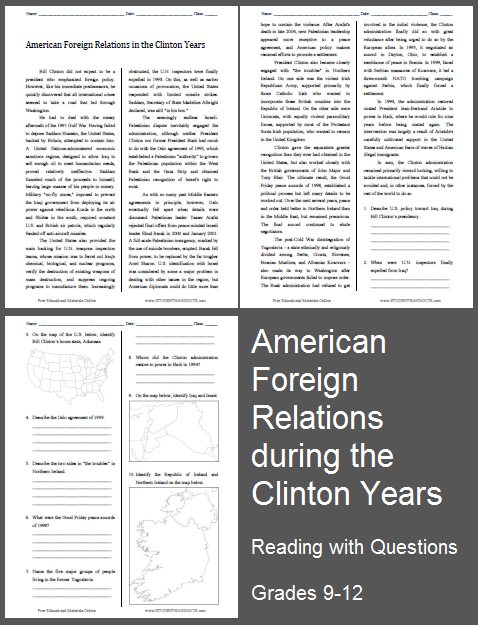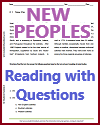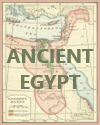| American Foreign Relations in the Clinton Years Reading with Questions |
|---|
| www.studenthandouts.com ↣ American History ↣ American History Readings |
 Bill Clinton did not expect to be a president who emphasized foreign policy. However, like his immediate predecessors, he quickly discovered that all international crises seemed to take a road that led through Washington.
Bill Clinton did not expect to be a president who emphasized foreign policy. However, like his immediate predecessors, he quickly discovered that all international crises seemed to take a road that led through Washington.
He had to deal with the messy aftermath of the 1991 Gulf War. Having failed to depose Saddam Hussein, the United States, backed by Britain, attempted to contain him. A United Nations-administered economic sanctions regime, designed to allow Iraq to sell enough oil to meet humanitarian needs, proved relatively ineffective. Saddam funneled much of the proceeds to himself, leaving large masses of his people in misery. Military "no-fly zones," imposed to prevent the Iraqi government from deploying its air power against rebellious Kurds in the north and Shiites in the south, required constant U.S. and British air patrols, which regularly fended off anti-aircraft missiles. The United States also provided the main backing for U.N. weapons inspection teams, whose mission was to ferret out Iraq's chemical, biological, and nuclear programs, verify the destruction of existing weapons of mass destruction, and suppress ongoing programs to manufacture them. Increasingly obstructed, the U.N. inspectors were finally expelled in 1998. On this, as well as earlier occasions of provocation, the United States responded with limited missile strikes. Saddam, Secretary of State Madeline Albright declared, was still "in his box." The seemingly endless Israeli-Palestinian dispute inevitably engaged the administration, although neither President Clinton nor former President Bush had much to do with the Oslo agreement of 1993, which established a Palestinian “authority” to govern the Palestinian population within the West Bank and the Gaza Strip and obtained Palestinian recognition of Israel's right to exist. As with so many past Middle Eastern agreements in principle, however, Oslo eventually fell apart when details were discussed. Palestinian leader Yasser Arafat rejected final offers from peace-minded Israeli leader Ehud Barak in 2000 and January 2001. A full-scale Palestinian insurgency, marked by the use of suicide bombers, erupted. Barak fell from power, to be replaced by the far tougher Ariel Sharon. U.S. identification with Israel was considered by some a major problem in dealing with other issues in the region, but American diplomats could do little more than hope to contain the violence. After Arafat's death in late 2004, new Palestinian leadership appeared more receptive to a peace agreement, and American policy makers resumed efforts to promote a settlement. President Clinton also became closely engaged with "the troubles" in Northern Ireland. On one side was the violent Irish Republican Army, supported primarily by those Catholic Irish who wanted to incorporate these British counties into the Republic of Ireland. On the other side were Unionists, with equally violent paramilitary forces, supported by most of the Protestant Scots-Irish population, who wanted to remain in the United Kingdom. Clinton gave the separatists greater recognition than they ever had obtained in the United States, but also worked closely with the British governments of John Major and Tony Blair. The ultimate result, the Good Friday peace accords of 1998, established a political process but left many details to be worked out. Over the next several years, peace and order held better in Northern Ireland than in the Middle East, but remained precarious. The final accord continued to elude negotiators. The post-Cold War disintegration of Yugoslavia—a state ethnically and religiously divided among Serbs, Croats, Slovenes, Bosnian Muslims, and Albanian Kosovars—also made its way to Washington after European governments failed to impose order. The Bush administration had refused to get involved in the initial violence; the Clinton administration finally did so with great reluctance after being urged to do so by the European allies. In 1995, it negotiated an accord in Dayton, Ohio, to establish a semblance of peace in Bosnia. In 1999, faced with Serbian massacres of Kosovars, it led a three-month NATO bombing campaign against Serbia, which finally forced a settlement. In 1994, the administration restored ousted President Jean-Bertrand Aristide to power in Haiti, where he would rule for nine years before being ousted again. The intervention was largely a result of Aristide's carefully cultivated support in the United States and American fears of waves of Haitian illegal immigrants. In sum, the Clinton administration remained primarily inward looking, willing to tackle international problems that could not be avoided and, in other instances, forced by the rest of the world to do so. Click here to print. Answer Key: (1) Economic sanctions, containment, no-fly zones; (2) 1998; (3) On map; (4) Established a Palestinian "authority" to govern the Palestinian population within the West Bank and the Gaza Strip; Palestinian recognition of Israel's right to exist; eventually fell apart; (5) Irish Republican Army: Catholic Irish who want to incorporate these British counties into the Republic of Ireland; Unionists: Protestant Scots-Irish who want to remain in the United Kingdom; (6) Political process for peace in Northern Ireland; (7) Serbs, Croats, Slovenes, Bosnian Muslims, and Albanian Kosovars; (8) Jean-Bertrand Aristide; (9) On map; (10) On map. |
 |  |  |  |  |
| UNIT I: | Early America | UNIT IX: | Discontent and Reform | ||
| UNIT II: | Colonial Period | UNIT X: | War, Prosperity, and Depression | ||
| UNIT III: | American Revolution | UNIT XI: | New Deal and World War II | ||
| UNIT IV: | New National Government | UNIT XII: | Postwar America | ||
| UNIT V: | Westward Expansion | UNIT XIII: | Decades of Change | ||
| UNIT VI: | Sectional Conflict | UNIT XIV: | New Conservatism | ||
| UNIT VII: | Civil War and Reconstruction | UNIT XV: | Into the Twenty-first Century | ||
| UNIT VIII: | Growth and Transformation | UNIT XVI: | Polarization and Deglobalization |
| www.studenthandouts.com ↣ American History ↣ American History Readings |








